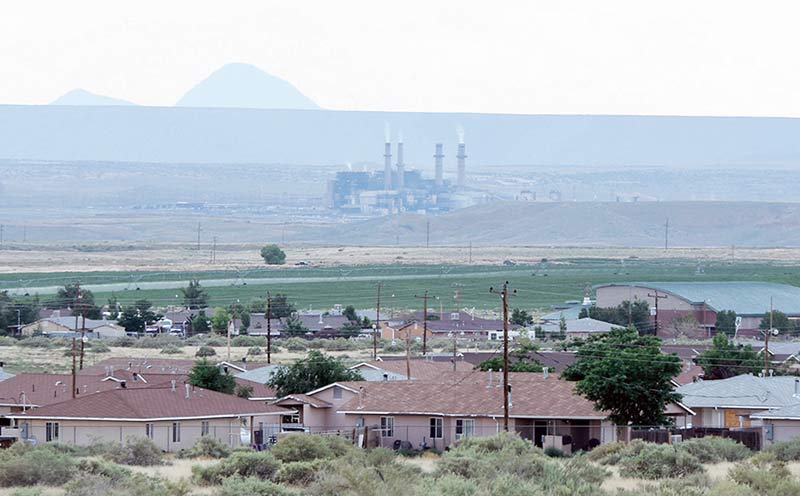
Guest Column | An analysis of San Juan Generating Station
By Seth Crank
Looking at the carbon capture technology program challenges, there are many reasons why we should not allow the San Juan Generating Station to continue operating because of new energy policy direction and technical specification limitations.

Navajo Times | File
The coal-fired San Juan Generating Station in Waterflow, New Mexico, pictured here, will close in 2022 if the New Mexico Public Regulatory Commission grants its permission. The PRC is currently hearing testimony on PNM’s plan to close the plant and replace it with a gas-fired plant and/or renewable energy.
New Mexico recently enacted a new energy policy called the Energy Transition Act with the goal to create dependable incentives for utility companies to achieve carbon free energy by 2050.
As a result, the state’s largest electricity provider, PNM, is not planning to receive power from the SJGS after June 2022. Instead, PNM proposed to install 500 megawatts of photovoltaics, 140 MW of wind, and 410 MW of batteries in place of SGJS.
The city of Farmington being highly dependent on SJGS for its economic opportunities are affected from this policy. Regardless of retaining only 5% ownership, Farmington is a co-owner who have an agreement to assume full ownership of the plant from PNM and other utility owners.
Farmington wants to preserve jobs and the tax base SJGS provides by finding new operators for SJGS. With closures quickly underway, Farmington scrambled to find an operator. Desperately, they found two firms willing to invest: Enchant Energy Corp. and Acme Equities LLC.
Out of the two, EEC was the most viable option for Farmington because their plan to retrofit SJGS with CCT would sequester carbon dioxide emissions to satisfy the policy’s goals and prevent SJGS from closing.
In August 2019, Farmington signed an agreement for EEC to acquire 95% ownership interest while the city maintained their 5% share. Although Farmington’s prior agreement with AE did not follow through. AE is known as a mysterious hedge fund with no experience in the power sector was a sign of Farmington’s desperation.
Despite Farmington’s uncanny AE agreement and EEC’s viable plan under the new energy policy it is not a smart move because CCT has many limitations and uncertainties.
With the state of New Mexico’s commitment to be 100% carbon neutral by 2050, will PNM’s renewable energy plan meet energy and economic demand and secure energy production for the next 30 years?
Analysis
Benefit-cost analyses prove CCT’s direction will be less viable over the next 30 years because ETA incentivizes top utility companies to transition from fossil fuels to carbon neutral energy production. This incentive is difficult for PNM to pass making CCT less secure.
In 2019, the New Mexico governor signed the ETA into law which focuses on eliminating emissions from energy production with the goal of producing 100% carbon-free energy by 2050. With this new energy policy in place, PNM incorporated a long-term strategic plan that aligned with the tools and benchmarks ETA provides to help successfully transition away from fossil fuels.
In fact, PNM stated, “ETA gives them a new financial tool to allow for the responsible closure of the SJGS in June of 2022 and exit of the Four Corners Power Plant in 2031.”
It is evident major utility suppliers are utilizing new energy policies to achieve carbon free energy production by 2050. Without these major utility providers interest to invest in any energy production from fossil fuels EEC’s long-term success in selling energy through coal will become more insecure over the next 30 years.
While new energy policies are becoming a desired goal for all major utility providers, CCT specifications also require more than what we initially anticipated.
First, coal is more expensive than renewables, natural gas, and battery storages combined. Second, CCT uses 50 to 60% more water. Third, coal resource limits the full integration of maximum renewables for the state. Fourth, CCT could use transmission lines that would otherwise be used to deliver lower cost to renewables to customers. Fifth, CCT will not be 100% effective as it will only reduce CO2 emissions by 90%. Lastly, carbon capture is not cost-effective at the scale of SJGS where there are many investment risks.
Even after implementing CCT, there are additional costs required to maintain its operation where 29% of SJGS power must be diverted to power the CCT machinery. With this additional input of energy requires CCT to use 40% more coal.
As you can see, CCT faces numerous insecurity challenges. It increases potential environmental impacts such as rapidly depleting water resources in a desert environment already facing record breaking drought. Larger land area would also need to be disturbed which means more liabilities to conduct reclamation work.
Conclusion
Renewable energy production is more secure over the long term and brings us one step closer to carbon neutral goals.
CCT’s plan will cost at least $1.4 billion while PNM’s transition to renewable energy plan will cost less over the next 30 years. If SJGS continues with CO2 sequestration as is, then its cost will fluctuate around $7.2 billion over the long-term scenario while PNM’s transition plan will cost around $5.9 billion.
This is a potential savings of $4 billion where residents will pay $6.87 on monthly residential utility bills. Under CCT’s program residents will pay $3.13 more per month.
While it is evident implementing CCT will provide higher economic support in terms of local jobs, revenue, security, and so many other incentives, this is another sign of desperation, so we should oppose this project.
Seth Crank, 30, is a graduate student at the University of Denver. He is of Navajo descent and is from Black Mesa, Arizona.








 Highway 264,
Highway 264, I-40, WB @ Winslow
I-40, WB @ Winslow